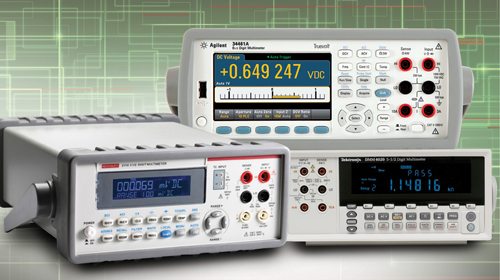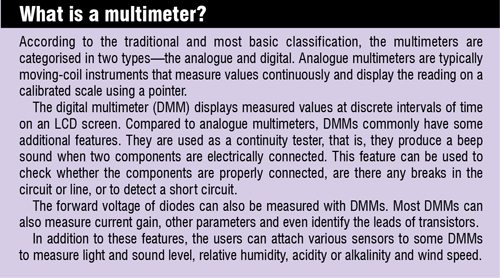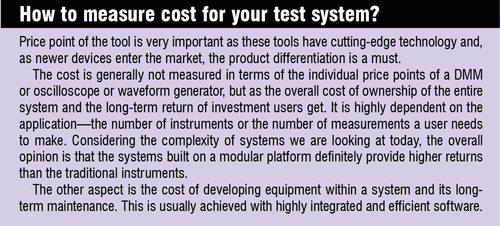A multimeter for an electronics engineer is as essential as a stethoscope is for a physician. It is an extremely useful, indispensable diagnostic tool for electronics design professionals, students and hobbyists—but is there anything more to it? This article provides some insights into the latest trends in multimeters
Anagha P
A multimeter is a very handy electronics measuring tool that helps in determining several electrical properties. Today, multimeters are available with advanced measuring capabilities for measuring capacitance in farads (F), inductance in henries (H), conductance in siemens (S), frequency in hertz (Hz), percentage duty cycle and also decibels (dB). With an appropriate test probe, such as a thermocouple, the temperature can also be determined in degree centigrade (°C) or Fahrenheit (°F).

The simplest electrical measurement testing tool, multimeter, has been evolving as a high-end electrical and electronics testing equipment to serve complex testing needs. Moreover, the latest multimeters incorporate a higher level of integration, connectivity and advanced features.
The Trends
The multimeters are either handheld or bench-top type. Handheld multimeters are primarily used for insulation and other measurements in field. Bench-top multimeters are used for higher-accuracy applications in research laboratories and electronics design houses.
The benefits of digital multimeters (DMMs) based on the increasingly popular modular platform, especially PCI eXtensions for instrumentation (PXI), are also discussed in this article.
Wireless-enabled DMMs
Engineers and technicians often come across situations where they have to take readings from an operating machine, or from points high above the ground, or measure multiple points at the same time. Improving safety and productivity at work are very important. It appears that multimeters are evolving to meet these demands from the users.
Wireless technology is used to solve these issues, without compromising the safety of the user. It allows to link distantly located multiple modules to a PC, tablet or smartphone. This allows remote logging of measurements in real time, and subsequently makes analysis and troubleshooting easier.
There are also Bluetooth-enabled multimeters available in the market. Wireless adaptors allowing log data from multiple DMMs in your computer/smartphone are also available now. Addition of these features provides an edge to the new multimeters over the traditional multimeters.
Multimeter with a remote display is another interesting product developed in this category. It allows detachment of the display from the body of the instrument and take readings from a remote location.
Software-defined instruments
Having highly scalable dense software architecture is very crucial for all the instruments. Hence in-line processing technology, such as field-programmable gate arrays (FPGAs) and real-time processors, are being adopted for multimeters. With the help of such technology, users can write an FPGA program to reconfigure the input/output (I/O) behaviour in order to define and design a particular multimeter as per requirement. Therefore, unlike the traditional multimeters, users can have a software-defined instrument rather than a vendor-defined one. The development time of a test system has been a great challenge and should be reduced considerably.


With regard to the wireless technology in the multimeter space, there are a growing number of software and mobile applications—some developed by vendors and the others by independent developers—to help analyse process and simplify user interface. It is important that the software controlling these instruments is highly integrated and efficient.
Integrated DMMs
Nowadays, people expect more measurement capabilities than the traditional voltage, current and resistance measurements that were typically performed by a multimeter. Research is ongoing for including more measurement capabilities, quick and better integration and development of the intuitive abilities of the application. This R&D is focussing on the inclusion of additional measurements by integrating DMM with other sensors, measuring devices and switches.
Currently, more devices such as voltage and current amplifiers, source measure units (SMUs) and digitisers or oscilloscopes are combined with the typical DMM functionality.
The integration of several instruments into a single module helps in developing ‘managed test systems’ that allow users to combine traditional multimeter functions with other elements/functions such as system monitoring, diagnostics, data logging, configuration and calibration.
Now it is no longer a stand-alone DMM, instead it has additional capabilities of attached elements that are combined in a single instrument. Such DMMs allow the users to take readings from multiple points and make more enhanced digital measurements in order to characterise their systems much more accurately, thus increasing customer efficiency.
So what we can expect in the DMM space is the ability to create, design and develop very high-end specification instruments.
The need for such integrated products depends on the application field, the variety of the user’s job roles and their affordability. Now there is a provision for the users to buy a base instrument with limited and affordable set of functionality and upgrade the features in the future.
In brief, the attempt in R&D is to focus not just on a single multimeter but also on driving customer efficiency by enhancing multimeters’ capabilities for a variety of measurements.







